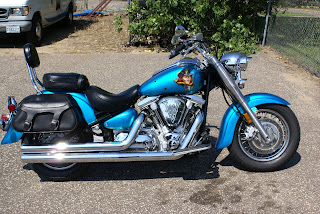
A few years ago I had never touched an airbrush. Now I paint murals on custom motorcycles and other projects for my new airbrushing company Billy and the Old Man Design. In the recent year I have been asked many times for tips on how to become an airbrush artist, here is my 5 step answer:
Step 1: Buy an airbrush & compressor
I prefer artist grade Iwata airbrushes, however there are a number of less expensive guns that are suitable especially for a hobby level committment. If you are planning to upgrade to a professional skill you will want to buy the best gun you can afford, it makes avery big difference. Compressors are less important and should fit the location you will be shooting out of. Keep in mind some compressors can be very loud.
Step 2: Set up a shop/area
Makes sure you have decent ventilation and a large enough area to set your objects to be painted. Overspray can easily get in electronic devices & appliances, so keep them covered or move them from the room.
Step 3: Find a mentor
Depending on your art background a mentor can be as simple as someone to show you the ins and outs of an airbrush gun. You can watch how-to DIY videos until you are blue in the face, but unless you have someone who has some experience standing next to you, there will be countless problems with overspray, bleeding, spitting, adhesion ect. All these problems can be simply answered and corrected with a few key tips and insights.
Step 4: Paint
Depending on your final project, you may want automotive paint(for motorcycles, signs or cars), waterbased paint (for canvas, fine art) or make-up based paint (for bodypainting, special effects). I use Xotic Colours for all my automotive work and prefer its quality above all other paints.
Step 5: Study & Practice
Youtube and other video sharing sites have a number of helpful airbrush teaching videos, as well as online walkthroughs. There are also a good deal of great DVDs or books available as guides. I would highly suggest Craig Frasier's videos, especially his mural videos. Again, YouTube and internet walk-throughs are the cheap and easy way to learn. Then practice practice practice. The more tips and tricks you can learn, and apply to your graphic or artwork the faster you will go from novice to master.

If you enjoyed this post, you might enjoy: Dragon Fly bike

1 comment:
Great and simple input, we're all tired of all the on and on going on.
Post a Comment